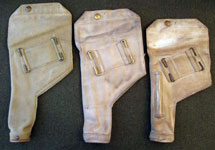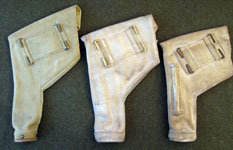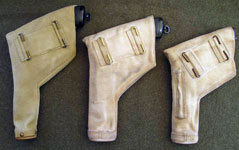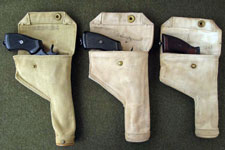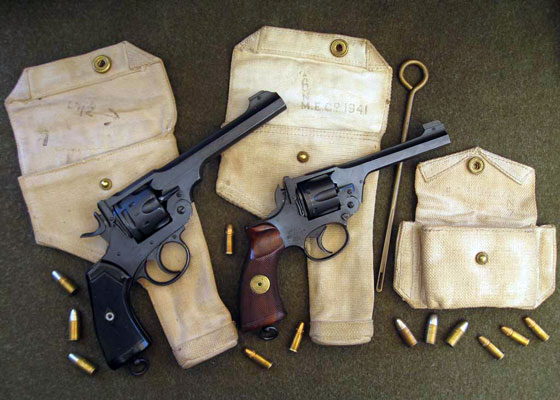Naval Undyed Webbing
INTRODUCTION
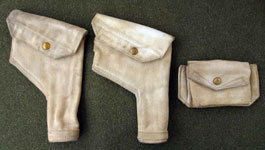
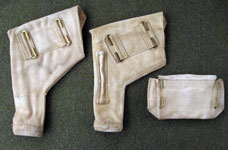 In 2011 previously unknown variants of Pattern 1919 Holsters and Ammunition pouches turned up on the retail market to tantalize collectors of British military accoutrements. They were manufactured in what appeared to be white webbing. Unfortunately, as is so often the case in many other disciplines - when a new species is discovered - the enthusiasts’ initial excitement was quickly blunted by cries of “Fake!” from ill-informed sceptics. Hopefully, this article can lay that issue to rest, while relating what is presently known about these fascinating newcomers to the web equipment lists.
In 2011 previously unknown variants of Pattern 1919 Holsters and Ammunition pouches turned up on the retail market to tantalize collectors of British military accoutrements. They were manufactured in what appeared to be white webbing. Unfortunately, as is so often the case in many other disciplines - when a new species is discovered - the enthusiasts’ initial excitement was quickly blunted by cries of “Fake!” from ill-informed sceptics. Hopefully, this article can lay that issue to rest, while relating what is presently known about these fascinating newcomers to the web equipment lists.
According to Dr. Richmond Dutton of Thin Read Line, the company that acquired these artefacts for resale to collectors, these items were part of a small lot of carefully sorted, handpicked web equipment. This particular grouping was part of a local Royal Marine Reserve Depot’s disposals, which had previously been purchased by another dealer. Evidently, the original lot consisted primarily of Pattern 1937 Web Equipment, so only the pieces thought to be Pattern 1919 Web Equipment were selected from it. This small lot consisted of a few Navy marked Braces, surprisingly, two Cutlass frogs, about fifty Pistol cartridge pouches and just ten Holsters. Of those ten Holsters, only three were of a unique type, which had several characteristics setting them apart from other Holsters – one of the most interesting of which was the fact that they had Canadian-made spigot fasteners.
Sadly, the building that had housed this RMR depot was torn down, along with its interesting history, as part of a dockland regeneration project. A small part of that history occurred during WW II, when the building contained an indoor Sten Gun range, constructed to resemble a city street for the practise of urban combat. According to a book on local history, the area’s Home Guard unit was also based there, using the range for their familiarization with street fighting – what fun that must have been for the old boys. Thankfully, they were never called upon to actually use these hastily acquired skills.
Currently there is a dearth of information regarding Navy store codes, with very little in the way of reference material available for consultation. With that in mind, before getting into the meat of this article, a recent development should be noted. Consistent with the ever-evolving quest to expand the knowledge base of accoutrement history, as this article was being written, two Karkee Web Research Team members, Carl Woods and John Bodsworth, un-earthed some information that caused some excitement among the more serious students of British Accoutrementalia. A 1961-dated abstract of FT naval codes proves, despite previously held opinions to the contrary, that the Royal Navy did indeed have some “made-as” white webbing. Not only that, but this unusual discovery shows this white webbing was referred to as “undyed”. This startling revelation takes the following form - FT 236 BELT, waist, extra large, undyed, Web Equipment, Patt. 1937 – along with various other sizes of Belts listed in the same manner.
Although it certainly cannot be assumed that the nomenclature of 1961 mirrors what the Navy used during WW II, it does represent the first official documentation of what term may have been used. In a sort of Back To The Future-type fashion, KW can use this blessing from the future of 1961, giving a more rational, “official” look to the tentative nomenclature of these WW II items, filing them as “Undyed” forms of Pattern 1919 Web Equipment. Being tentative, this nomenclature will have to serve as a placeholder until more concrete, Navy documentation becomes available. In the meantime, the issue is still not fully resolved and the “Where-to-put-it-and-what-to-call-it?” discussion at KW has been both a spirited, as well as on-going debate.
Note: In the interest of clarity, it should be mentioned that throughout this article, the terms “Pattern 1919” and “Patt.‘19”, refer to the Pattern 1919 Web Equipment issued to Britain’s Royal Navy. They are not to be confused with the curiously designated, Canadian Pattern 1919, which was just one of at least three sets of khaki web equipments with different pattern numbers issued to the Canadian Army between the World Wars. For more information on this odd state of affairs concerning Canadian Pattern nomenclature, refer to the Introduction to KW's section on Web Equipment, Pattern 1925.
A complication emerges with the use of the term “undyed” though, as it really describes a manufacturing characteristic, rather than a colour. Most, if not all, web equipment, regardless of its final hue, was made from webbing woven from cotton yarn originally delivered to the mills undyed, in a bleached, white state. This was done to facilitate the yarn being dyed to any desired colour. It becomes apparent then, that in the case of the subject items, “bleached, “white” and “undyed” are so closely linked that they may probably be considered synonymous. Unfortunately, the use of “undyed”, although technically accurate, can lead to some confusion when attempting to compare, or contrast, colour variations. To alleviate any potential misunderstanding, a compromise has been made. Throughout the course of this article, these three items will often be referred to by the term that best reflects the government’s intent, as well as the probable terminology used by the end user – that is, white.
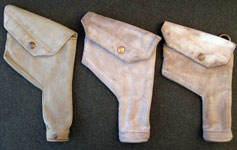
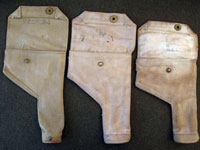 Initially, these subject Holsters and Cartridge pouches were advertised as standard Navy Pattern 1919 Web Equipment and were purchased with that understanding. Distinct differences were a later discovery. The photos accompanying the listings showed them to be rather grubby, in what appeared to be a lighter than normal shade of khaki. This was nothing out of the realm of the vagaries of fading and the shading variations often produced by the whims of photographic lighting. Upon arrival, the two new, but rather dirty additions were photographed next to a known Patt. ’19 Holster for a Pattern 1919-type comparison.
Initially, these subject Holsters and Cartridge pouches were advertised as standard Navy Pattern 1919 Web Equipment and were purchased with that understanding. Distinct differences were a later discovery. The photos accompanying the listings showed them to be rather grubby, in what appeared to be a lighter than normal shade of khaki. This was nothing out of the realm of the vagaries of fading and the shading variations often produced by the whims of photographic lighting. Upon arrival, the two new, but rather dirty additions were photographed next to a known Patt. ’19 Holster for a Pattern 1919-type comparison.
Note: Employing a harmless cleaning technique related by the seller which has been used for years by antique restorers, the holsters’ exteriors were rubbed with balls of fresh white bread. Even though taken in the early stages, the majority of the rest of the photos in this article exhibit the appreciable improvement in appearance and amount of grime that this simple process can remove.
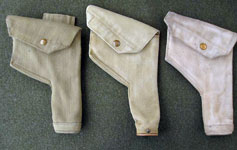
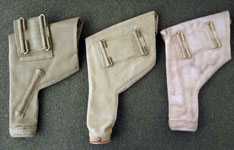 The 1924, first-issue, Web Equipment, Naval, Pattern 1919 Pistol case was itself a much lighter shade of khaki than any of the Army Holsters in the collection. The first thought was that this lighter colouration was perhaps simply a characteristic of Navy web equipment. The degree of similarity in this gradual, khaki shade differentiation can be seen when comparing an Army Case, pistol, web, with brass hooks to both a normal first issue and a white - tentatively labelled, second issue -Web Equipment, Naval, Pattern 1919 Pistol case. This erroneous colour variation assessment was soon dispelled upon their arrival. An examination of the interior of both Holsters, as well as the protected areas inside the Cartridge pouch, quickly revealed them all to have originally been white, or undyed, rather than khaki.
The 1924, first-issue, Web Equipment, Naval, Pattern 1919 Pistol case was itself a much lighter shade of khaki than any of the Army Holsters in the collection. The first thought was that this lighter colouration was perhaps simply a characteristic of Navy web equipment. The degree of similarity in this gradual, khaki shade differentiation can be seen when comparing an Army Case, pistol, web, with brass hooks to both a normal first issue and a white - tentatively labelled, second issue -Web Equipment, Naval, Pattern 1919 Pistol case. This erroneous colour variation assessment was soon dispelled upon their arrival. An examination of the interior of both Holsters, as well as the protected areas inside the Cartridge pouch, quickly revealed them all to have originally been white, or undyed, rather than khaki.
Perhaps this is what led to the rush to judgment in some quarters, charging that these items were not Pattern 1919 at all, but actually pieces of R.A.F. Pattern 1925 web equipment that had nefariously been bleached, then had bogus Navy markings added. By a detailed examination of the artefacts, it will be shown that this opinion is wrong, in several regards. If a more thoughtful, reflective approach had been taken initially, it might have prompted the logical question. Why would anyone knowingly fake something not previously known by collectors to exist, that is White, or Undyed, Pattern 1919 web equipment? This was compounded by no mention of this very interesting fact, when it was put on the international retail market. It was described simply as “Pattern 1919”. This would certainly be a self-defeating exercise if deception were involved and, with so few units available, not a particularly rewarding one either.
Case, pistol, web, white (Pattern 1919, second issue?)
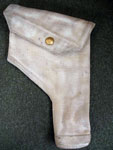
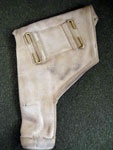
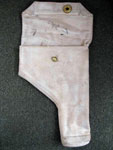 Of these three undyed items, this Pistol case presents the researcher with the most intriguing questions. Due to several unique characteristics, its origin is presently shrouded in mystery.
Of these three undyed items, this Pistol case presents the researcher with the most intriguing questions. Due to several unique characteristics, its origin is presently shrouded in mystery.
Even a cursory examination quickly shreds the “Bleached R.A.F. Patt.’25” theory. With only two hooks and no external cleaning rod sleeve, other than its colour, this Holster appears to be nothing more exotic than a second issue, Pattern 1919 Pistol case. However, once the flap is lifted, the differences become apparent, with the most obvious feature being that it also lacks an internal cleaning rod sleeve.
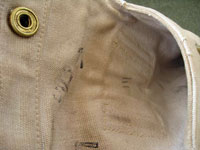 This particular characteristic is held in common with the first issue Patt. ’19 Pistol case, to which dimensionally it is almost identical, apart from a slight shortening in overall length. This reduction occurred with the elimination of the wooden “cotton reel”. On the undyed Holster, the spigot and crown parts of the fastener have been placed differently, moved right and left, respectively. This results in very little change to the angle of the flap, in its closed position.
This particular characteristic is held in common with the first issue Patt. ’19 Pistol case, to which dimensionally it is almost identical, apart from a slight shortening in overall length. This reduction occurred with the elimination of the wooden “cotton reel”. On the undyed Holster, the spigot and crown parts of the fastener have been placed differently, moved right and left, respectively. This results in very little change to the angle of the flap, in its closed position.
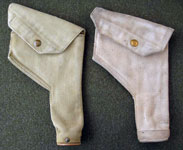
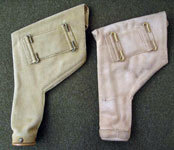
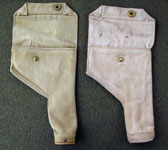 Another mystery, revealed by the open flap, is that the Fastener, snap, crown, bottom part of the Fastener, brass bears the stamp of a Canadian company, United Carr.
Another mystery, revealed by the open flap, is that the Fastener, snap, crown, bottom part of the Fastener, brass bears the stamp of a Canadian company, United Carr.
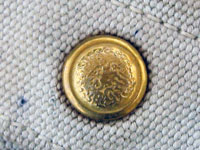
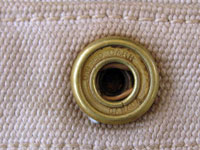 One published source has stated that these Canadian fasteners were exported to other Commonwealth countries, to be used by their local web equipment manufacturers. This is certainly possible and may very well have occurred but - as yet - both documentation and photographic proof have been elusive. Perhaps there is a KW reader who could provide a photo of an example of a United Carr fastener on a web item made - and plainly marked - as a product of a non-Canadian manufacturer. Such a photograph would not only further our knowledge, but would also verify the theory of United Carr being part of the proven phenomenon of cross-Commonwealth pollination in the manufacture of British military supplies.
One published source has stated that these Canadian fasteners were exported to other Commonwealth countries, to be used by their local web equipment manufacturers. This is certainly possible and may very well have occurred but - as yet - both documentation and photographic proof have been elusive. Perhaps there is a KW reader who could provide a photo of an example of a United Carr fastener on a web item made - and plainly marked - as a product of a non-Canadian manufacturer. Such a photograph would not only further our knowledge, but would also verify the theory of United Carr being part of the proven phenomenon of cross-Commonwealth pollination in the manufacture of British military supplies.
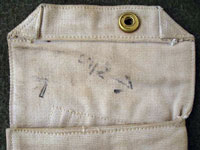 The lightly stamped, faded Royal Navy property marks are easily discerned and show themselves to be anything but recent additions. Unfortunately, the inside of the flap is completely devoid of any stampings identifying manufacturer and date. This Holster’s origin is therefore subject to much speculation. The first, most logical explanation, for this lack of maker’s marks would be that they simply disappeared when the case was bleached. However, the post-manufacture bleaching theory is completely un-supported by any physical evidence, although there is proof to the contrary.
The lightly stamped, faded Royal Navy property marks are easily discerned and show themselves to be anything but recent additions. Unfortunately, the inside of the flap is completely devoid of any stampings identifying manufacturer and date. This Holster’s origin is therefore subject to much speculation. The first, most logical explanation, for this lack of maker’s marks would be that they simply disappeared when the case was bleached. However, the post-manufacture bleaching theory is completely un-supported by any physical evidence, although there is proof to the contrary.
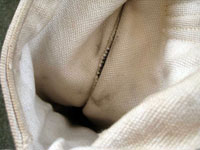
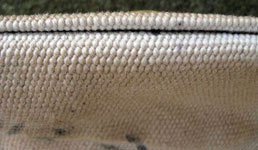 Spreading the internal stitched seam under the trigger guard area, as well as the inside of the top of the flap, reveals black lines, not the subdued, randomly shaped, shading variations of blue-grey that would be expected to result from bleaching. Although the sewn ends of the web in the internal seams are black, the adjacent cut edges of the fabric are white. If bleached, there would surely be a mingling of faded colour along this edge and not the sharply delineated contrast of black and white. This would seem to indicate that these black lines are nothing more than the guidelines for the pattern cutters and sewing machine operators. The almost bright, un-oxidized condition of all the brass hardware is still further proof that this case never saw a bleaching vat, a point explored more fully in comparison with the following white Holster.
Spreading the internal stitched seam under the trigger guard area, as well as the inside of the top of the flap, reveals black lines, not the subdued, randomly shaped, shading variations of blue-grey that would be expected to result from bleaching. Although the sewn ends of the web in the internal seams are black, the adjacent cut edges of the fabric are white. If bleached, there would surely be a mingling of faded colour along this edge and not the sharply delineated contrast of black and white. This would seem to indicate that these black lines are nothing more than the guidelines for the pattern cutters and sewing machine operators. The almost bright, un-oxidized condition of all the brass hardware is still further proof that this case never saw a bleaching vat, a point explored more fully in comparison with the following white Holster.
Though the manufacturer of this case remains unknown at present, the construction technique should immediately eliminate two companies. The folded and stitched style of assembly, with no integral weaving, leads to the conclusion that any involvement by the Mills Equipment Company, or M. Wright & Sons Ltd, is highly unlikely. If accepted as being a Patt.’19 variant, this Case can be added to the very short list of Patt.’19 Web Equipment (a Pistol case and a Canadian made Brace attachment) presently known to have been made by companies other than Mills.
.
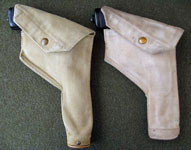
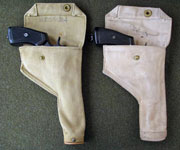 Having the early type of Canadian fastener with the “pebbled” crown, along with being almost a straight duplication of the 1st issue Patt.’19 Case, other than the lack of the “cotton reel”, are clues that tend to point back to Canada as the country of origin. Canada’s earliest production of Pattern 1937 Holsters were direct copies of Mills’ squarer designs, but were folded and stitched, due to lack of looms capable of integral weaving. Perhaps this case represents an earlier pattern that they also reproduced. As the Canadian Navy was issued .45 and .455 calibre revolvers, it would make sense that the larger capacity Patt.’19 Holster would also be manufactured. The suspicion exists that this holster may not be a second issue variation at all, but instead, a uniquely Canadian version of the first issue Patt. ’19 Pistol case, updated with the later, more sensible, web muzzle cap.
Having the early type of Canadian fastener with the “pebbled” crown, along with being almost a straight duplication of the 1st issue Patt.’19 Case, other than the lack of the “cotton reel”, are clues that tend to point back to Canada as the country of origin. Canada’s earliest production of Pattern 1937 Holsters were direct copies of Mills’ squarer designs, but were folded and stitched, due to lack of looms capable of integral weaving. Perhaps this case represents an earlier pattern that they also reproduced. As the Canadian Navy was issued .45 and .455 calibre revolvers, it would make sense that the larger capacity Patt.’19 Holster would also be manufactured. The suspicion exists that this holster may not be a second issue variation at all, but instead, a uniquely Canadian version of the first issue Patt. ’19 Pistol case, updated with the later, more sensible, web muzzle cap.
If this Pistol case had other than a Canadian origin, the manufacturing date could potentially have a much wider possible range. The most common collector understanding has it that large-scale production of web equipment started in Canada with the introduction of Patt. ’37 in the 1939-40 timeframe. While this may be true as far as Patt. ’37 is concerned, as we have seen, evidence exists that there was some local manufacture of pieces of the earlier patterns prior to that date. Knowledge of United Carr fastener production dates would prove quite helpful but, in the event this Holster was not Canadian-made, it should probably be inserted into the Pattern 1919 chronology just after the first issue Pistol case, but ahead of what is currently known as the second issue type. As product improvements are normally added, not subtracted, it stands to reason that this Case, with its lack of a cleaning rod sleeve, more properly represents a first production, second issue Case, rather than a later variant of the second issue Case which has the internal sleeve.
Whatever its origin, the process that contributed to this odd Holster ending up as the property of His Majesty’s Royal Navy is just another of its mysteries. Strangely enough, as mysterious as it is, this is the only one of the three undyed items to show any evidence of ever being used. Some slightly stained rub marks inside, where the butt and trigger-guard made contact show that even if only rarely, this Case had been used to provide carriage for a revolver.
Note: In another testament to the sentiment that knowledge is in a constant state of flux and again while this article was being written, KW was fortunate enough to be sent photos of another, previously unknown variation of a web Holster pattern with a tantalizing Canadian association. Not to let the cat out of the bag prematurely, as this new Holster will no doubt be subject to its own inclusion elsewhere on KW, but it – along with the subject undyed Holster – tends to further support the possibility that Canada may have produced at least a few examples of their own versions of earlier pattern web Holsters, before Patt. ’37 production commenced. Further developments are awaited.
Addendum: The future is here, in this instance at least! The Holster Terry is referring to is a previously unknown Canadian variation of the Pattern 1925 Holster, pistol, Colt, now shown on the Patt. '25 Pistol Equipment page.
Case, pistol, web, white (Pattern 1919, third issue?)
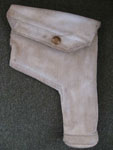
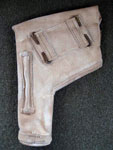
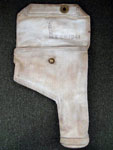 Thankfully, unlike the previous mysterious Case, the professionalism and quality control of Mills Equipment Company leaves no doubt as to this Holster’s origin and manufacture date. It is quite clearly, but lightly, stamped "M. E. Co. 1941”, while also bearing the property mark of the Royal Navy.
Thankfully, unlike the previous mysterious Case, the professionalism and quality control of Mills Equipment Company leaves no doubt as to this Holster’s origin and manufacture date. It is quite clearly, but lightly, stamped "M. E. Co. 1941”, while also bearing the property mark of the Royal Navy.
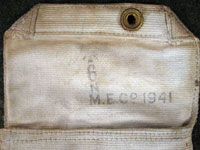
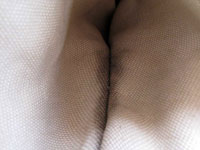 Externally, although discoloured by the passage of 70-odd years, this Holster appears to be a white version of a typical, R.A.F. Pattern 1925 Holster, with two hooks and a vertical cleaning rod sleeve on the back. A look inside confirms that initial assessment. Spreading the internal seam below the trigger guard area, down to the stitching, reveals an irregular band of faded blue-grey colouration still present in these more protected areas of the web material. No mystery here. This is proof positive that this Holster was indeed bleached.
Externally, although discoloured by the passage of 70-odd years, this Holster appears to be a white version of a typical, R.A.F. Pattern 1925 Holster, with two hooks and a vertical cleaning rod sleeve on the back. A look inside confirms that initial assessment. Spreading the internal seam below the trigger guard area, down to the stitching, reveals an irregular band of faded blue-grey colouration still present in these more protected areas of the web material. No mystery here. This is proof positive that this Holster was indeed bleached.
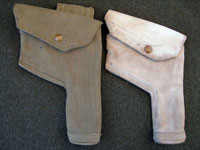
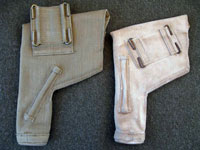 Before the sceptics among us exultantly cry, “See!” or, the more juvenile, “I told you so!” a much closer examination is required. For marking authenticity comparison purposes, a Case, pistol, web, with brass hooks made by the Mills Equipment Company in 1939, was chosen, being fairly close in manufacturing date to the subject holster. This case is obviously genuine, as well as uncommon enough on the ground to likely be unavailable to the majority of those unscrupulous types, who may be looking for a real manufacturer’s logo to serve as a pattern to counterfeit.
Before the sceptics among us exultantly cry, “See!” or, the more juvenile, “I told you so!” a much closer examination is required. For marking authenticity comparison purposes, a Case, pistol, web, with brass hooks made by the Mills Equipment Company in 1939, was chosen, being fairly close in manufacturing date to the subject holster. This case is obviously genuine, as well as uncommon enough on the ground to likely be unavailable to the majority of those unscrupulous types, who may be looking for a real manufacturer’s logo to serve as a pattern to counterfeit.
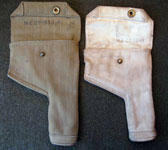
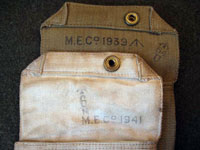 Other than the manufacture date, the maker’s markings are identical. Surprisingly, the ink stampings are even lighter on the two-years’ newer, white Holster. Perhaps this might be a result of bleach residue in the fabric causing abnormal fading, or - more simply - just less ink on the stamp at the time. In any case, these markings are certainly not recent. The Navy property mark, made with a separate stamp, is faded to an equal degree.
Other than the manufacture date, the maker’s markings are identical. Surprisingly, the ink stampings are even lighter on the two-years’ newer, white Holster. Perhaps this might be a result of bleach residue in the fabric causing abnormal fading, or - more simply - just less ink on the stamp at the time. In any case, these markings are certainly not recent. The Navy property mark, made with a separate stamp, is faded to an equal degree.
Further inspection revealed a very interesting, if not commonly known, inspection mark on the left of the inside of the mouth of the Holster. This numerical stamping is unusual in that it is smaller than most other inspector’s marks and lacks any other component part, such as the usual broad arrow, standing simply on its own. This mark is evident on both of these holsters and in the same numerical range - “50” on the white holster and “58” on the khaki.
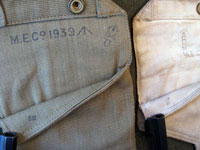
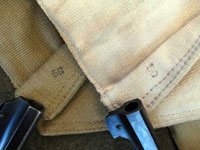 A mark this small, in such an obscure location, is not likely to be something that would be apparent to the average fake artist, but it is something that speaks volumes for the authenticity of the markings.
A mark this small, in such an obscure location, is not likely to be something that would be apparent to the average fake artist, but it is something that speaks volumes for the authenticity of the markings.
Being genuine, these markings could have only have been stamped on after the bleaching process, otherwise they would have disappeared along with the previously dyed, blue-grey colouration. As it was Mills that did the stamping, this Holster was probably taken from stock on the shelf in the plant at the time. This would have been an expedient way to fulfil what was probably a small order of white Holsters for the Navy, judging by the very low number of examples so far extant. As these Holsters were still Mills’ property before they were bleached, the R.A.F. would have had no involvement in their manufacture. As 1941 was the year blue-grey Patt.’37 was introduced, rather than expending the time, material and labour to add a third hook to the last of the Patt. ’25 Holsters on hand, it appears that Mills saw a golden opportunity. Knowing the Navy’s primary concern was more likely to be the colour of the finished product, rather than the process by which it was achieved, some bright spark had the brilliant idea of turning dyed Holsters into “undyed” ones. By the simple bleaching of some of the Patt. ’25 Holsters left in stock, thus returning the webbing to an “undyed” state, the company could fulfil the Navy contract, while ridding itself of now un-needed inventory - thus obsolete, blue-grey, R.A.F. Patt.’25 Holsters were simply modified to become white, Navy Patt.’19 Pistol cases.
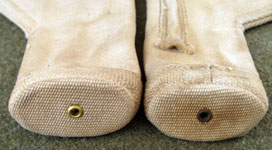 The condition of the brass hardware is a further testament to whether or not an item was bleached. As can be seen in the photos of the drain-hole grommets, the muzzle cap of the bleached 1941-dated Holster has been stained reddish-brown by the severe oxidation of the brass grommet. The grommet itself no longer even looks like brass, but now appears as if it was made from a ferrous metal that has rusted. Conversely, other than the storage discolouration, the un-dated Holster has a relatively clean muzzle cap, with the drain-hole grommet still quite obviously recognized as being made of brass.
The condition of the brass hardware is a further testament to whether or not an item was bleached. As can be seen in the photos of the drain-hole grommets, the muzzle cap of the bleached 1941-dated Holster has been stained reddish-brown by the severe oxidation of the brass grommet. The grommet itself no longer even looks like brass, but now appears as if it was made from a ferrous metal that has rusted. Conversely, other than the storage discolouration, the un-dated Holster has a relatively clean muzzle cap, with the drain-hole grommet still quite obviously recognized as being made of brass.
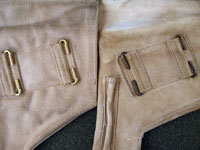 The condition of the waist belt hooks of both Holsters also emphasizes the effect that bleaching has on brass. While the hooks on the un-dated Holster are still nice and clean, almost bright in fact, the bleached, 1941-dated Holster’s hooks are a uniform brown, with just small spots of bright brass peeking through on the rubbed, more prominent bends.
The condition of the waist belt hooks of both Holsters also emphasizes the effect that bleaching has on brass. While the hooks on the un-dated Holster are still nice and clean, almost bright in fact, the bleached, 1941-dated Holster’s hooks are a uniform brown, with just small spots of bright brass peeking through on the rubbed, more prominent bends.
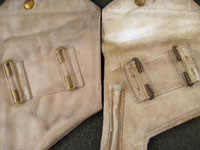 Flipping both sets of hooks over reveals a couple of interesting facts. The oxidized hooks of the bleached 1941 Holster have created brown stains where they rested on the web material, probably while drying after the bleaching process, while the clean, un-oxidized hooks of the un-dated Holster have actually protected the web underneath from the accumulated filth of storage. These protected areas are still white! Looking between the nasty, brown lines of staining under the hooks of the bleached Holster, it can be seen that, to a lesser degree, these hooks performed the same service for this Holster. Although not quite as obvious as on the undated Holster, these protected areas on the bleached Holster are definitely a lighter shade than the areas immediately adjacent.
Flipping both sets of hooks over reveals a couple of interesting facts. The oxidized hooks of the bleached 1941 Holster have created brown stains where they rested on the web material, probably while drying after the bleaching process, while the clean, un-oxidized hooks of the un-dated Holster have actually protected the web underneath from the accumulated filth of storage. These protected areas are still white! Looking between the nasty, brown lines of staining under the hooks of the bleached Holster, it can be seen that, to a lesser degree, these hooks performed the same service for this Holster. Although not quite as obvious as on the undated Holster, these protected areas on the bleached Holster are definitely a lighter shade than the areas immediately adjacent.
This is important evidence, because it helps to establish the end of a time line of sorts regarding the events that created the bleached Holster. When it was bleached, the brass oxidized, consequently staining the web beneath. The hooks stayed in this position for years, as they also did on the undated Holster, protecting the areas they covered, as the exposed portions of the Holsters were slowly discoloured from many decades of storage dirt, grime and fading. Thus the physical evidence provided by the bleached Holster shows the following sequence of events: At some point in time it was first manufactured as a standard, second issue, Pattern 1925 Holster then stored, likely in Mills' own facility. Luckily faced with an opportunity to rid itself of some obsolete overstock, while economically fulfilling a small contract, it was then later bleached. When thoroughly dry, Mills inspected, marked and dated it in 1941 for shipment to the Navy. The Navy, in turn, inspected and property marked it, but probably never used it, placing it in store for years, where it slowly gathered the grime that changed the original undyed colour on the exterior to the dingy, beige, off-white it is now.
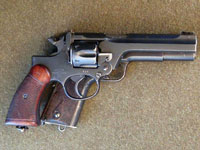 The Pattern 1919 Pistol case was designed to contain the .455 Webley Mk VI revolver with its 6-inch barrel, so it easily contains the smaller .380 Enfield No. 2 revolver with a 5-inch barrel. However, the Pattern 1925 Holster was originally designed to carry the .455 Colt Government Model, a more compact, semi-automatic pistol, which also had a 5-inch barrel. Although the barrel lengths are the same, the configuration of the grip and trigger guard areas of the .380 revolver and the .455 pistol are quite different.
The Pattern 1919 Pistol case was designed to contain the .455 Webley Mk VI revolver with its 6-inch barrel, so it easily contains the smaller .380 Enfield No. 2 revolver with a 5-inch barrel. However, the Pattern 1925 Holster was originally designed to carry the .455 Colt Government Model, a more compact, semi-automatic pistol, which also had a 5-inch barrel. Although the barrel lengths are the same, the configuration of the grip and trigger guard areas of the .380 revolver and the .455 pistol are quite different.
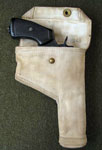
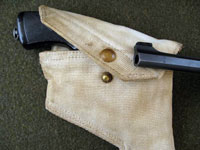 This requires the relocation of the fastener crown to allow it to accommodate a No. 2 revolver. However, the shorter length of the Patt. ’25 Holster usually prevents the flap from closing comfortably over the grip of the longer Mk VI revolver. This modification to the location of the fastener crown was officially made to 1st issue Pattern 1925 Holsters by both British and Canadian Air Orders.
This requires the relocation of the fastener crown to allow it to accommodate a No. 2 revolver. However, the shorter length of the Patt. ’25 Holster usually prevents the flap from closing comfortably over the grip of the longer Mk VI revolver. This modification to the location of the fastener crown was officially made to 1st issue Pattern 1925 Holsters by both British and Canadian Air Orders.
With the .380 revolver designed to replace the .455, by 1941 the versatility to contain both may no longer have been an important consideration. Beginning with the standard, first issue Patt. ’19 Case, the photos show comparisons of the fitment of the revolvers in the holsters in the probable, chronological order.
Pouch, cartridge, web, white (Pattern 1919, second issue?)
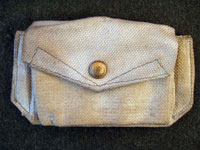
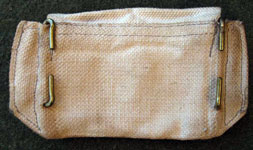 Once again, apart from the colour, this pouch appears to be a typical, second issue, Patt. ’19 Cartridge pouch.
Once again, apart from the colour, this pouch appears to be a typical, second issue, Patt. ’19 Cartridge pouch.
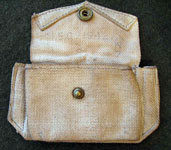
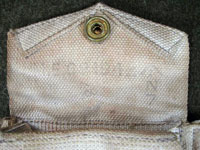 Thankfully it is marked, although very faintly, as an inspected Mills product made in 1942 and, like the two Holsters, it is stamped as Navy property.
Thankfully it is marked, although very faintly, as an inspected Mills product made in 1942 and, like the two Holsters, it is stamped as Navy property.
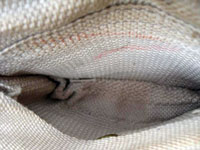
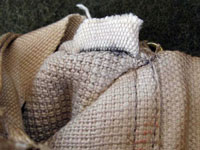
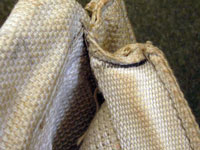 Despite having the same maker as the tentatively titled third issue Patt.’19 Holster, the Pouch shows no evidence of being bleached after manufacture. Spreading the concealed interior seams reveals only more white webbing, without a hint of darker, or blue grey areas. As can be seen by the photos, other than a possible inventory mark in the form of a scribbled red check mark on the back wall, the inside of the Pouch is almost spotless, therefore never used for its intended purpose. The only dark areas visible are the black lines, obviously sewing guidelines, on either end of the guard strip sewn across the mouth of the Pouch.
Despite having the same maker as the tentatively titled third issue Patt.’19 Holster, the Pouch shows no evidence of being bleached after manufacture. Spreading the concealed interior seams reveals only more white webbing, without a hint of darker, or blue grey areas. As can be seen by the photos, other than a possible inventory mark in the form of a scribbled red check mark on the back wall, the inside of the Pouch is almost spotless, therefore never used for its intended purpose. The only dark areas visible are the black lines, obviously sewing guidelines, on either end of the guard strip sewn across the mouth of the Pouch.
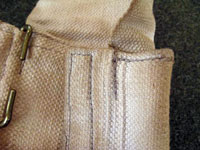 This integrally woven Pouch has had all the sewing done with grey thread, further proof that this Pouch was undyed when manufactured, as bleaching would have removed the thread colour too. Exposing an exterior, protected area on the side of the Pouch confirms this thread was always grey and not just darkened by the grime of age.
This integrally woven Pouch has had all the sewing done with grey thread, further proof that this Pouch was undyed when manufactured, as bleaching would have removed the thread colour too. Exposing an exterior, protected area on the side of the Pouch confirms this thread was always grey and not just darkened by the grime of age.
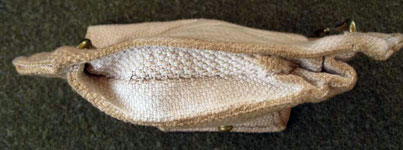 The original colour of the Pouch’s web material is most dramatically displayed when the folds forming its bottom are extended. The stark contrast between the white webbing of the folded area and the khaki colour of the exposed exterior, is an indisputable verification of the ravages of time on even un-used, stored equipment.
The original colour of the Pouch’s web material is most dramatically displayed when the folds forming its bottom are extended. The stark contrast between the white webbing of the folded area and the khaki colour of the exposed exterior, is an indisputable verification of the ravages of time on even un-used, stored equipment.
The physical evidence shows that this Cartridge pouch’s history followed a similar, if not identical, timeline as the bleached Holster, except it never suffered the indignity of the bleaching process. It was manufactured as a standard, second issue type, Navy Patt.’19 Cartridge pouch, but in new, undyed webbing, not bleached blue-grey, or khaki. This would seem to indicate that by the time of this contract in 1942, Mills had no overstocks of blue-grey Patt.’25 Pouches on the shelves, or for that matter, khaki Patt.’19 examples. Without a stock of previously made, dyed pouches available for bleaching, the contract was filled by weaving new webbing directly from the bleached, but undyed, cotton yarn. With there being five times more undyed Cartridge pouches than undyed Holsters in the original disposal lot, it would seem likely that there may be more Holsters waiting to be discovered.
CONCLUSIONS
As in any trial, it is the facts - gleaned from all the available evidence - that prove the case. Detailed examination and careful analysis of the artefacts prove conclusive. The markings are age-appropriate and genuine. Two of the items were manufactured new from webbing woven from undyed cotton yarn, while the third has a more “colourful” story - rebirth as “undyed” from previously made, dyed inventory. The external grubbiness of all three items, juxtaposed to the surprisingly clean condition of the interiors, points to years of storage under less than ideal conditions.
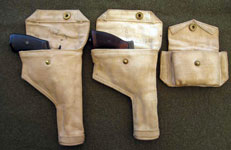 So there it is… All evidence points to these three items being exactly what they were presented to the public as, when first they reached the collector market - that is, ex-Navy property, Pattern 1919 Web Equipment. As the Holsters and Pouch bear witness, they remain as they left the mill - not the product of any post-manufacture modifications, or suspect manipulations. When these items were first discovered, white Patt.’19 was completely unknown. More surprisingly, the term ”undyed” then surfaced, albeit in connection with Naval Patt.’37 - further evidence that these items are not just an odd, much lighter shade of khaki.
So there it is… All evidence points to these three items being exactly what they were presented to the public as, when first they reached the collector market - that is, ex-Navy property, Pattern 1919 Web Equipment. As the Holsters and Pouch bear witness, they remain as they left the mill - not the product of any post-manufacture modifications, or suspect manipulations. When these items were first discovered, white Patt.’19 was completely unknown. More surprisingly, the term ”undyed” then surfaced, albeit in connection with Naval Patt.’37 - further evidence that these items are not just an odd, much lighter shade of khaki.
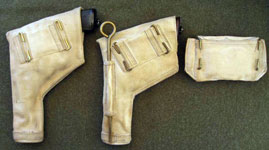
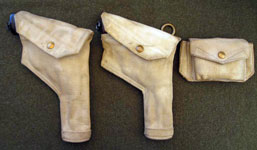 Although the ex-Patt.’25 Holster is a bit of a cheat, despite the manufacturer’s understandable intent, the “mystery” Holster and Cartridge pouch are representative of the very few finished products known to have been made from webbing woven from undyed cotton yarn - thus remaining the same colour the yarn was when it first arrived at the mill. Why they were produced in undyed webbing is subject to further investigation. Now that it has been learned that these items came from a Royal Marine Reserve Depot, use by RMR military police units is a distinct possibility - one which also might help explain the small number discovered so far. No doubt there are other possible explanations. Perhaps there is a keen-eyed enthusiast and KW reader with another specimen, contemporary photograph, or some form of documentary evidence, which might help reveal more of the story, as well as the unit originally intended to be equipped with these variations of Pattern 1919 Web Equipment.
Although the ex-Patt.’25 Holster is a bit of a cheat, despite the manufacturer’s understandable intent, the “mystery” Holster and Cartridge pouch are representative of the very few finished products known to have been made from webbing woven from undyed cotton yarn - thus remaining the same colour the yarn was when it first arrived at the mill. Why they were produced in undyed webbing is subject to further investigation. Now that it has been learned that these items came from a Royal Marine Reserve Depot, use by RMR military police units is a distinct possibility - one which also might help explain the small number discovered so far. No doubt there are other possible explanations. Perhaps there is a keen-eyed enthusiast and KW reader with another specimen, contemporary photograph, or some form of documentary evidence, which might help reveal more of the story, as well as the unit originally intended to be equipped with these variations of Pattern 1919 Web Equipment.
Karkee Web would like to extend a special thank you to Dr. Richmond Dutton, for his much-appreciated help in relating information regarding the disposal history of these interesting artefacts.
Terry Hawker 2012
